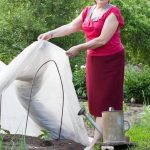Are you interested in starting a vegetable garden but don’t have a lot of space to work with? Look no further. In this article, we’ll explore small area vegetable gardening ideas that will help you make the most of limited space. Whether you have a small backyard, balcony, or even just a few containers on a patio, there are plenty of creative ways to grow your own vegetables.
When it comes to small area vegetable gardening ideas, choosing the right vegetables is essential. In this section, we’ll discuss which types of vegetables thrive in small spaces and provide tips for selecting the best varieties for your specific growing conditions. From compact bush varieties to fast-growing crops, there are plenty of options for those with limited gardening space.
In addition to choosing the right vegetables, container gardening can be a game-changer for small areas. We’ll explore creative container gardening techniques that allow you to maximize every inch of space available.
From hanging vertical planters to window boxes and even repurposed items like old buckets and crates, there are countless ways to grow vegetables in containers. So let’s dive into the world of small area vegetable gardening and discover how you can create a bountiful garden no matter how little space you have.
Choosing the Right Vegetables for Small Spaces
When it comes to small area vegetable gardening ideas, choosing the right vegetables is crucial for maximizing your limited space. Not all vegetables are suitable for small areas, so it’s important to select plants that will thrive in containers or raised beds. Certain vegetables are well-suited for compact gardens and can provide a bountiful harvest without taking up too much space.
One of the best options for small area vegetable gardening is to focus on compact or dwarf varieties of popular vegetables. For example, bush or determinate tomato plants can be ideal for small spaces, as they stay relatively compact and produce plenty of fruit. Similarly, varieties of lettuce, spinach, and radishes that have a smaller footprint are perfect for container gardening.
Another factor to consider when choosing vegetables for small spaces is the growth habit of the plant. Vegetables that grow vertically, such as pole beans or cucumbers, are excellent choices for small area gardening. These plants can be trained to grow upwards using trellises or other vertical supports, maximizing space while still providing a generous yield.
In addition to choosing the right types of vegetables, it’s also important to consider the climate and growing conditions in your specific area. Some vegetables may require full sun or have specific soil needs, so it’s essential to select varieties that will thrive in your unique growing environment.
| Vegetable | Best Suited For |
|---|---|
| Bush Tomatoes | Container Gardening |
| Dwarf Lettuce | Raised Beds |
| Pole Beans | Vertical Gardening |
Creative Container Gardening for Small Areas
When it comes to small area vegetable gardening ideas, container gardening is a great way to maximize space and still enjoy the benefits of homegrown produce. Whether you have a tiny balcony, patio, or just a few square feet of outdoor space, creative container gardening can help you grow a variety of vegetables in small areas.
Choosing the Right Containers
One of the first steps in creative container gardening for small areas is selecting the right containers for your vegetables. Look for pots and planters that are deep enough to accommodate the root systems of your chosen vegetables. Additionally, consider using hanging baskets, vertical planters, or even repurposed items like buckets or crates to make the most of your limited space.
Optimizing Vertical Space
Vertical gardening techniques can be particularly useful for small area vegetable gardening. Utilize trellises, stakes, or vertical planters to grow vining vegetables such as tomatoes, cucumbers, and peas. This not only saves valuable ground space but can also create an attractive green wall effect in your small garden area.
Creative Plant Combinations
Experiment with planting different vegetables together in the same containers to make the most of your limited space. For example, pairing shallow-rooted herbs like basil with deeper-rooted lettuce or spinach can allow you to grow multiple crops in one container without overcrowding. Just be mindful of each plant’s specific needs for sunlight and water when creating these combinations.
By utilizing creative container gardening techniques such as choosing the right containers, optimizing vertical space, and experimenting with plant combinations, small area vegetable gardeners can enjoy a bountiful harvest even in limited spaces. With some thoughtful planning and innovation, anyone can successfully grow their own vegetables at home regardless of their available outdoor space.
Vertical Gardening Techniques for Limited Space
When space is limited, gardeners need to get creative with their planting options. Vertical gardening offers a great solution for those looking to maximize the space they have available. By utilizing vertical gardening techniques, small area vegetable gardeners can grow a wide range of plants in a limited amount of space.
One popular method of vertical gardening is the use of trellises and arbors. These structures provide support for climbing vegetables such as tomatoes, cucumbers, and beans, allowing them to grow upwards instead of spreading out across the ground. This not only saves space but also makes harvesting and maintenance much easier.
Another effective technique for vertical gardening in small spaces is the use of hanging planters and wall-mounted containers. These options are perfect for growing herbs, lettuces, and smaller vegetables that don’t require a large root system. By hanging these containers on walls or fences, gardeners can take advantage of unused vertical space and create a visually appealing garden area.
In addition to trellises, arbors, hanging planters, and wall-mounted containers, small area vegetable gardeners can also explore the option of using pole systems or tiered plant stands to expand their planting space upwards. With the right combination of these vertical gardening techniques, even the smallest outdoor or indoor spaces can become productive vegetable gardens.
| Vertical Gardening Technique | Benefit |
|---|---|
| Trellises and Arbors | Support for climbing vegetables; saves space |
| Hanging Planters and Wall-Mounted Containers | Utilizes unused vertical space; visually appealing |
| Pole Systems or Tiered Plant Stands | Expands planting space upwards in small areas |
Utilizing Raised Beds for Small Area Vegetable Gardening
When it comes to small area vegetable gardening, utilizing raised beds can be a game-changer. Raised beds not only offer better drainage and soil quality, but they also provide a defined space for your vegetables to thrive. Here are some tips and ideas for using raised beds in small area vegetable gardening:
- Choose the right size: When it comes to raised beds in small spaces, size matters. Opt for smaller raised beds that fit well in your limited space while still providing enough room for your chosen vegetables to grow.
- Stackable options: Consider stackable or tiered raised bed options to maximize vertical space. This allows you to grow more vegetables in a smaller footprint, making the most of your limited gardening area.
Additionally, raised beds can be customized to fit the specific needs of your small area vegetable garden. For example:
- Use trellises: Incorporate trellises into your raised beds to allow vining vegetables such as tomatoes, cucumbers, and peas to grow vertically, saving ground space.
- Interplanting: Utilize the square foot gardening method by interplanting different vegetables within the same raised bed. This efficient use of space allows you to grow a variety of crops in a small area.
Raised beds offer not just practical solutions for limited space gardening, but also aesthetic appeal. They can add visual interest and structure to a small vegetable garden, creating an organized and well-defined growing area. By incorporating raised beds into your small area vegetable gardening plan, you can maximize both productivity and aesthetics in your limited outdoor space.
Tips for Maximizing Space in Small Vegetable Gardens
Small vegetable gardens can be challenging to manage, especially when space is limited. However, with the right strategies, it is possible to maximize the area and yield a bountiful harvest. One effective tip for maximizing space in small vegetable gardens is to practice interplanting.
This technique involves planting different types of vegetables close together so that they can benefit from each other’s growth. For example, tall plants such as corn can provide shade for lower-growing plants like lettuce, while also making efficient use of vertical space.
Another important aspect of maximizing space in small vegetable gardens is to make use of succession planting. This method involves planting new crops in the same spot once the first crop has been harvested. By doing this, you can ensure a continuous supply of fresh produce throughout the growing season without needing additional space. Additionally, utilizing companion planting techniques can help make the most out of small areas by fostering symbiotic relationships between different plant species.
Furthermore, incorporating trellises or cages into your small area vegetable garden can help support climbing plants such as tomatoes, cucumbers, or peas, allowing you to take advantage of vertical space and conserve ground area. Additionally, utilizing hanging baskets or vertical planters can also provide additional room for growing a variety of vegetables without taking up valuable ground space.
By implementing these tips and techniques for maximizing space in small vegetable gardens, gardeners can create productive and efficient growing environments even within limited areas.
Overall, there are numerous ways to maximize the potential of a small area vegetable garden through creative planning and innovative gardening methods. With careful consideration and strategic planting choices, anyone can grow a thriving and plentiful garden regardless of size limitations.
Maintaining and Caring for Small Area Vegetable Gardens
Regular Watering and Feeding
One of the most important aspects of maintaining a small area vegetable garden is to ensure that your plants are getting the water and nutrients they need to thrive. In small spaces, it can be easy for soil to dry out quickly, so regular watering is essential.
Consider installing a drip irrigation system or using a watering can with a narrow spout to target the roots of your plants. Additionally, be sure to feed your vegetables with a balanced fertilizer to promote healthy growth.
Weeding and Pest Control
Because small area vegetable gardens often have limited space, it’s crucial to stay on top of weeding to prevent unwanted plants from stealing nutrients and sunlight from your vegetables. Regularly inspect your garden for any signs of pests or diseases, and take action promptly if you notice any issues. Consider using natural pest control methods such as companion planting or introducing beneficial insects to keep pests at bay.
Pruning and Training Plants
In a small vegetable garden, it’s important to make the most of every inch of space. Proper pruning and training techniques can help maximize productivity and prevent overcrowding. Encourage vertical growth in vining plants like tomatoes and cucumbers by providing support structures such as trellises or cages. Regularly trim back any overgrown foliage to maintain good air circulation and prevent disease.
By following these maintenance tips, you can ensure that your small area vegetable garden remains healthy and productive throughout the growing season. With proper care, even the tiniest of spaces can yield an abundant harvest of fresh, homegrown produce.
Success Stories and Inspiration for Small Area Vegetable Gardening
For those with limited space, it can be discouraging to think about starting a vegetable garden. However, there are many success stories and inspiring examples of individuals who have managed to grow an abundance of vegetables in small areas. These stories serve as motivation for those who may feel that their space is too restricted for gardening.
Here are some success stories and inspirational examples of small area vegetable gardening:
- The urban apartment dweller who transformed their small balcony into a thriving vegetable garden, showcasing how even the tiniest of spaces can be utilized for growing fresh produce.
- The family who maximized their tiny backyard by using raised beds and vertical gardening techniques, demonstrating how strategic planning and creativity can result in a bountiful harvest.
- The community garden plot shared by multiple neighbors, illustrating the power of collaboration and teamwork in making the most of limited land for vegetable gardening.
These success stories offer encouragement and inspiration for anyone considering small area vegetable gardening ideas. They show that with the right approach, it is possible to overcome spatial limitations and grow an abundance of fresh, healthy vegetables.
Whether you have a small balcony, a compact backyard, or just a few square feet of space to spare, these success stories prove that you can still create a productive vegetable garden. With some creativity and determination, even the smallest spaces can yield an impressive harvest of homegrown produce.
Conclusion and Final Tips for Successful Small Area Vegetable Gardening
In conclusion, small area vegetable gardening can be a rewarding and practical endeavor for those with limited outdoor space. By choosing the right vegetables, utilizing creative container gardening, implementing vertical gardening techniques, and utilizing raised beds, individuals can still enjoy the benefits of growing their own produce. With careful planning and attention to maximizing space, even the smallest of areas can yield a bountiful harvest.
One final tip for successful small area vegetable gardening is to regularly maintain and care for your garden. This includes watering, fertilizing, weeding, and monitoring for pests or diseases. By staying on top of these tasks, you can ensure that your plants remain healthy and productive throughout the growing season.
As you embark on your small area vegetable gardening journey, take inspiration from success stories of others who have achieved abundant yields in limited spaces. Whether it’s a neighbor’s thriving balcony garden or a community garden plot bursting with produce, there are countless examples of how small area vegetable gardening can be both feasible and fruitful. With dedication and creativity, anyone can turn a small space into a flourishing vegetable garden.
And remember, even if you encounter challenges along the way, don’t be discouraged – every setback is an opportunity to learn and improve your skills as a gardener. Happy planting.
Frequently Asked Questions
What Vegetables Can Be Grown in Small Spaces?
In small spaces, vegetables like lettuce, spinach, radishes, green onions, and herbs like basil and mint are great options. These plants don’t require a lot of space to grow and can be easily managed in containers or raised beds.
How Do You Layout a Small Vegetable Garden?
When laying out a small vegetable garden, it’s important to make the most of the space available. Utilize vertical gardening techniques like trellises for vining plants, stagger plantings to maximize sunlight exposure, and consider companion planting to optimize space and promote healthy growth.
How Do You Grow a Lot of Vegetables in a Small Area?
To grow a lot of vegetables in a small area, intensive planting is key. This involves closely spacing plants together to make the most efficient use of available space.
Raised beds and container gardening can also help maximize the number of plants grown in a limited area. Additionally, succession planting allows for multiple crops throughout the growing season from the same plot of land.

If you’re looking to get into vegetable gardening, or are just looking for some tips on how to make your current garden better, then you’ve come to the right place! My name is Ethel and I have been gardening for years. In this blog, I’m going to share with you some of my best tips on how to create a successful vegetable garden.





